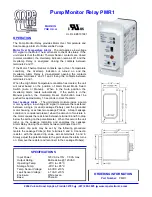
⎯
248
⎯
6 F 2 S 0 8 4 6
Zone R2 tripping
Set the scheme switch [ZR2BT] to "On". (The [ZR2BT] default setting is "Off".)
Check that three-phase time-delayed final tripping is performed for all kinds of faults. Faults
should be set midway zone R1 and zone R2.
Check that the operating time is 1-1.5 cycle plus zone R2 timer setting.
Check that the indications and recordings are correct.
Zone ND tripping
Set the scheme switch [ZNDBT] to "On". (The [ZNDBT] default setting is "Off".)
Check that three-phase time-delayed final tripping is performed for all kinds of faults. Faults
should be set midway zone 3 and zone ND.
Check that the operating time is 1-1.5 cycle plus zone ND timer setting.
Check that the indications and recordings are correct.
Zone 1X tripping
Set the scheme switch [SCHEME] to "Z1EXT", and [ARC-M] to "TPAR" or "SPAR&TPAR" or
"SPAR". CB ready condition (binary input signal BI10) and 52A, 52B and 52C must be
established.
Faults should be set midway between zone 1 and zone 1X.
Check that it performs instantaneous single-phase or three-phase tripping depending on the fault
types and setting of autoreclose mode selection switch [ARC-M].
Check that the operating time is 1-1.5 cycle or less.
Check that the indications and recordings are correct.
Command Protection
The followings are described as default setting for binary inputs and binary outputs.
PUP tripping
Set the scheme switch [SCHEME] to "PUP".
Energize the binary input BI4 ("Trip signal") to simulate a trip permission signal reception and
apply a zone 2 fault.
Check that instantaneous single-phase or three-phase tripping is performed depending on the fault
types and setting of autoreclose mode selection switch [ARC-M].
De-energize the binary input BI4 and apply a zone 2 fault. Check that PUP tripping does not occur.
Apply a zone 1 fault, and check that binary output relay BO13 ("Send signal") operates.
Check that the indications and recordings are correct.
POP tripping
Set the scheme switch [SCHEME] to "POP", [WKIT] and [ECHO] to "off".
Energize the binary input BI4 to simulate a trip permission signal reception and apply a zone 2
fault.
Check that instantaneous single-phase or three-phase tripping is performed depending on the fault
types and setting of autoreclose mode selection switch [ARC-M].
Summary of Contents for GRZ100 B Series
Page 264: ... 263 6 F 2 S 0 8 4 6 Appendix A Block Diagram ...
Page 271: ... 270 6 F 2 S 0 8 4 6 ...
Page 272: ... 271 6 F 2 S 0 8 4 6 Appendix B Signal List ...
Page 307: ... 306 6 F 2 S 0 8 4 6 ...
Page 308: ... 307 6 F 2 S 0 8 4 6 Appendix C Variable Timer List ...
Page 310: ... 309 6 F 2 S 0 8 4 6 Appendix D Binary Input Output Default Setting List ...
Page 321: ... 320 6 F 2 S 0 8 4 6 ...
Page 322: ... 321 6 F 2 S 0 8 4 6 Appendix E Details of Relay Menu and LCD Button Operation ...
Page 331: ... 330 6 F 2 S 0 8 4 6 ...
Page 340: ... 339 6 F 2 S 0 8 4 6 Appendix G Typical External Connections ...
Page 377: ... 376 6 F 2 S 0 8 4 6 ...
Page 384: ... 383 6 F 2 S 0 8 4 6 Appendix J Return Repair Form ...
Page 388: ... 387 6 F 2 S 0 8 4 6 Customer Name Company Name Address Telephone No Facsimile No Signature ...
Page 389: ... 388 6 F 2 S 0 8 4 6 ...
Page 390: ... 389 6 F 2 S 0 8 4 6 Appendix K Technical Data ...
Page 401: ... 400 6 F 2 S 0 8 4 6 ...
Page 402: ... 401 6 F 2 S 0 8 4 6 Appendix L Symbols Used in Scheme Logic ...
Page 405: ... 404 6 F 2 S 0 8 4 6 ...
Page 406: ... 405 6 F 2 S 0 8 4 6 Appendix M Example of Setting Calculation ...
Page 417: ... 416 6 F 2 S 0 8 4 6 ...
Page 418: ... 417 6 F 2 S 0 8 4 6 Appendix N IEC60870 5 103 Interoperability and Troubleshooting ...
Page 434: ... 433 6 F 2 S 0 8 4 6 Appendix P Inverse Time Characteristics ...
Page 437: ... 436 6 F 2 S 0 8 4 6 ...
Page 438: ... 437 6 F 2 S 0 8 4 6 Appendix Q Failed Module Tracing and Replacement ...
Page 444: ... 443 6 F 2 S 0 8 4 6 Appendix R Ordering ...
Page 447: ......
















































